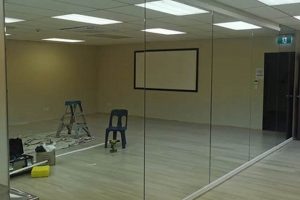A cooperative workspace model, often involving artists, designers, or other creative professionals, allows individuals to share resources and infrastructure. This shared environment might include equipment, studio space, and administrative support. A group of potters, for example, might establish a communal studio, splitting the cost of kilns, pottery wheels, and glaze materials, while also gaining access to a larger working area than any single member could afford alone.
This collaborative approach fosters a sense of community, providing opportunities for peer learning, mentorship, and networking. Reduced overhead expenses and shared administrative burdens can free up individuals to focus on their core creative activities. Historically, similar models have existed in various forms, often emerging as a response to economic constraints or a desire for collaborative artistic exploration.
The structure and benefits inherent in this arrangement influence a range of operational aspects, including membership models, resource allocation, and the collaborative dynamic among its participants. These are key considerations for understanding the overall impact and success of this type of creative environment.
Successfully navigating a shared creative workspace requires careful planning and attention to the needs of all members. The following guidelines aim to foster a productive and collaborative atmosphere.
Tip 1: Establish Clear Membership Guidelines: Define specific criteria for admission, outlining expectations for participation, contribution, and adherence to shared rules. This prevents conflicts and ensures a cohesive group dynamic.
Tip 2: Develop a Comprehensive Resource Allocation System: Create a transparent and equitable system for allocating resources, such as equipment usage time, storage space, and access to shared amenities. This minimizes disputes and ensures fair access for all members.
Tip 3: Implement a Robust Communication Strategy: Establish clear channels for communication regarding schedules, equipment maintenance, project updates, and any other relevant information. This promotes transparency and facilitates collaboration.
Tip 4: Foster a Culture of Respect and Collaboration: Encourage members to actively support each other’s work, provide constructive feedback, and participate in collaborative projects. This builds a strong community and enhances the overall creative output.
Tip 5: Regularly Review and Adapt the Operating Model: Schedule periodic reviews of the shared workspace’s operating model, addressing any challenges or inefficiencies that may arise. This ensures that the structure remains responsive to the evolving needs of its members.
Tip 6: Define Intellectual Property Rights Clearly: Establish a clear understanding of ownership and usage rights for works created within the shared space, especially in collaborative projects. A written agreement helps prevent future disputes.
Tip 7: Establish Conflict Resolution Mechanisms: Implement a clear and agreed-upon process for resolving disputes between members. This might involve mediation or arbitration by a designated facilitator. Having a pre-defined process helps address issues fairly and efficiently.
Adhering to these guidelines can cultivate a productive and supportive environment, maximizing the benefits of a shared creative workspace for all participants.
Understanding the dynamics within these spaces is crucial for optimizing individual contributions and fostering a vibrant creative community.
Effective allocation and maintenance of shared resources are critical to the operational viability and collaborative potential of a collective workspace. The method in which these are managed directly impacts individual productivity, group cohesion, and overall financial sustainability.
- Equipment Accessibility and Scheduling
A well-defined system for accessing and scheduling equipment, such as specialized machinery or software licenses, is essential. This system should prioritize fairness and minimize downtime. Example: An online booking system that allows members to reserve equipment in advance, ensuring equitable access and preventing scheduling conflicts.
- Supply Procurement and Inventory Control
Centralized purchasing of shared supplies allows for bulk discounts and reduces individual expenditure. Accurate inventory tracking prevents shortages and ensures availability when needed. Example: A collective purchasing agreement with suppliers to secure lower prices on materials, coupled with a shared inventory spreadsheet accessible to all members.
- Space Optimization and Allocation
Efficient use of shared studio space maximizes functionality and prevents congestion. Clearly defined areas for specific activities, combined with flexible workspace options, accommodate diverse needs. Example: Zoning the workspace into areas for wet work, dry work, and computer-based tasks, while providing adjustable workstations for individual projects.
- Maintenance and Repair Protocol
A proactive maintenance schedule and a clear protocol for reporting and addressing equipment malfunctions prevent disruptions and extend the lifespan of shared assets. Example: A shared calendar for routine maintenance tasks, combined with a designated contact person for reporting repairs and coordinating service calls.
These resource management strategies are central to the success of a collective creative workspace. By fostering efficiency, equity, and sustainability, they facilitate a collaborative environment where individuals can thrive and collectively achieve their creative goals.
2. Collaborative Project Development
Collaborative project development within a shared creative workspace is a symbiotic relationship, where the structure of the environment actively fosters and benefits from joint endeavors. The shared space provides resources, diverse skill sets, and a supportive community, creating fertile ground for the conception and execution of projects that individual members might not be able to undertake alone. This collaboration is not merely an optional add-on but a fundamental aspect, frequently acting as a catalyst for innovation and expanding the capabilities of those involved. Consider, for instance, a collective of textile artists and graphic designers who pool their resources to create a line of limited-edition printed fabrics, blending traditionally separate disciplines into a single cohesive product. The existence of the workspace facilitates this, providing the space, equipment, and network necessary for its realization.
The importance of collaborative project development is observed in multiple dimensions. Firstly, it allows members to access a wider range of expertise, enriching the outcome and offering opportunities for learning and skill enhancement. Secondly, it can reduce individual risk and financial burden by spreading costs and responsibilities across a group. Lastly, it enhances the visibility of the collective, attracting new members, clients, and collaborators. A real-world example is seen in architectural cooperatives that undertake joint design competitions, thereby pooling their talents, increasing their chances of winning, and raising the profile of each participating firm. The collaborative process, when carefully managed, results in synergistic benefits, amplifying the impact of individual contributions.
In conclusion, collaborative project development constitutes a critical component within a shared creative workspace. It drives innovation, expands capabilities, and enhances visibility, contributing to the sustainability and success of the collective. While challenges such as conflict resolution and equitable distribution of credit may arise, the potential benefits far outweigh the risks. Recognizing and actively fostering collaborative projects is, therefore, essential for those seeking to maximize the value of participating in a collective creative environment. The capacity to effectively develop such projects is a defining characteristic of a thriving workspace of this type.
3. Community Skill Exchange
Within a shared creative workspace, community skill exchange serves as a pivotal mechanism for individual growth and collective advancement. This exchange, both formal and informal, directly impacts the level of expertise available within the group, influencing project outcomes and fostering an environment of continuous learning. Skill exchange stems from the diversity of talent and experience present in the collective. For example, a photographer might offer workshops on lighting techniques, while a graphic designer shares expertise in branding strategies. This reciprocal sharing builds a stronger skill base within the studio, increasing its overall value and appeal.
The importance of community skill exchange is multifaceted. It reduces the need for external training, minimizes reliance on outside experts, and enhances the members’ individual portfolios. Furthermore, this knowledge sharing strengthens the communal bond, encouraging collaboration and mutual support. One illustrative scenario is a collective of artists who organize regular peer review sessions. These sessions provide constructive critique and identify areas for improvement, directly impacting the quality of individual artwork and fostering a culture of collaborative growth. Another practical application involves a group of filmmakers who cross-train each other in various aspects of production, from cinematography to sound design, ensuring a more versatile and self-sufficient team.
In summary, community skill exchange constitutes a fundamental component of a thriving collective. It fosters individual growth, promotes collective development, and enhances the overall value of the shared workspace. Challenges may include managing time commitments and ensuring equitable participation, yet the benefits of this knowledge sharing far outweigh the obstacles. Understanding the dynamics and importance of skill exchange is vital for any individual or group seeking to maximize the potential of this collaborative model. It helps promote the self-sufficient dynamic that is central to the collaborative philosophy.
4. Mentorship Relationships
Mentorship relationships within a shared creative workspace provide a structured avenue for knowledge transfer and professional development. The physical proximity and communal environment naturally foster these connections. Experienced members offer guidance to less seasoned individuals, accelerating skill acquisition and mitigating common pitfalls. These relationships, which are generally organic, serve to enhance the quality of the work produced within the collective. The mentorship may be specific to a given craft, with a senior potter guiding a junior member in glaze techniques, or it may encompass broader professional topics, such as pricing strategy or client communication. The studio collective, in effect, becomes a learning ecosystem where expertise is shared and cultivated.
The advantages of these relationships extend beyond immediate skill enhancement. Mentors benefit from the process, refining their own understanding of their craft through explanation and demonstration. Mentees gain access to practical knowledge and insights that are difficult to obtain through formal education. A studio collective might also host visiting experts who conduct workshops or offer one-on-one mentoring sessions. This external input provides fresh perspectives and introduces new techniques, further stimulating growth. Success hinges on the deliberate cultivation of a supportive and open environment, where both mentors and mentees are valued and encouraged to participate actively.
In conclusion, mentorship relationships function as a crucial component of the studio collective model. These relationships enhance the capabilities of individual members and contribute to the overall reputation and success of the collective. While challenges may arise in matching mentors and mentees or in managing expectations, the benefits of fostering these connections far outweigh the difficulties. Recognizing and actively supporting mentorship relationships is essential for maximizing the potential of the shared creative workspace, securing a more skilled and engaged collective membership in the long term.
5. Reduced Individual Overhead
The studio collective, by its very nature, provides a mechanism for minimizing individual financial burdens associated with creative practice. The aggregation of resources and expenses across multiple members results in significant cost savings compared to the expenses incurred when operating independently. This reduction in overhead allows individual creatives to allocate resources more effectively to materials, marketing, or further professional development. The practical effect is increased financial flexibility and a greater capacity to sustain creative endeavors over the long term. For example, a ceramic artist working independently may bear the full cost of kiln purchase and maintenance, studio rental, and insurance. Within a collective, these costs are shared among multiple members, dramatically reducing the financial strain on any single individual.
This economic advantage is not simply a matter of cost savings; it also creates opportunities for access to higher-quality equipment or more desirable locations that might otherwise be unattainable. A group of photographers, for instance, could collectively afford to lease a studio space with superior lighting and facilities compared to what any single member could justify independently. Furthermore, shared administrative costs such as website maintenance, accounting services, and marketing materials are divided among the members, further decreasing the individual overhead. The ability to focus on creative work, rather than being bogged down by administrative tasks and financial anxieties, is a substantial benefit of the studio collective model.
In conclusion, the concept of reduced individual overhead is intrinsically linked to the success and sustainability of the studio collective. It is a primary driver for the formation of these groups and a tangible benefit that directly impacts the creative output and financial stability of its members. While effective management of shared resources is crucial to realizing these savings, the potential for reduced overhead remains a powerful incentive and a significant advantage of this collaborative model. The studio collective’s sustainability is directly tied to the ability of each member to maintain a manageable financial burden, allowing for continuous creative output.
6. Enhanced Creative Exposure
The studio collective inherently fosters enhanced creative exposure for its members. This increased visibility stems from the shared resources, collaborative efforts, and communal ethos that characterize such environments. Enhanced exposure, in turn, translates to increased opportunities, recognition, and professional growth for individual creatives within the collective.
- Group Exhibitions and Showcases
Collectives often organize joint exhibitions and showcases, providing a platform for members to present their work to a wider audience than they could individually. These events attract potential clients, collectors, and media attention, enhancing the visibility of each participating artist. An example includes a collective of sculptors hosting an open studio event, drawing visitors who might not otherwise encounter their individual work.
- Shared Marketing and Promotion
Collectives can pool resources to implement joint marketing and promotional campaigns, amplifying their reach and impact. This might include developing a shared website, creating a collective portfolio, or participating in joint advertising initiatives. A design collective, for instance, could create a single, unified website showcasing the diverse skill sets of its members, attracting clients seeking a comprehensive range of design services.
- Cross-Promotion and Networking
The collaborative nature of collectives facilitates cross-promotion and networking opportunities. Members can recommend each other’s services to their respective networks, expanding their reach and generating new leads. A collective of writers, for example, can leverage their individual connections to secure speaking engagements or publication opportunities for fellow members.
- Increased Credibility and Recognition
Association with a reputable collective can enhance an individual creative’s credibility and recognition. Being part of a respected group can signal a certain level of quality and professionalism, attracting clients and collaborators who value the collective’s reputation. A collective of jewelers, for example, might earn a reputation for innovative designs and high-quality craftsmanship, lending credibility to its individual members.
These facets of enhanced creative exposure directly contribute to the overall success and sustainability of the studio collective. The increased visibility and recognition generated by these efforts attract new members, clients, and collaborators, reinforcing the collective’s value and impact. The synergistic effect of shared resources and collaborative promotion elevates the visibility of individual members beyond what they could achieve in isolation, solidifying the studio collective as a powerful platform for creative growth.
7. Collective Marketing Efforts
Within the framework of the studio collective, concerted promotional activities are a critical component for ensuring visibility and sustainability. These joint efforts amplify the impact of individual marketing initiatives, creating a synergistic effect that benefits all members.
- Shared Branding and Identity
Establishing a unified brand identity allows the studio collective to present a cohesive image to the public. This may include a shared logo, color scheme, and messaging that communicates the collective’s values and expertise. For instance, a collective of photographers might create a website showcasing their diverse portfolios under a single brand, emphasizing the range of photographic services available through the group. The unified identity enhances brand recognition and attracts clients seeking a one-stop solution.
- Joint Advertising Campaigns
Collective marketing efforts enable the execution of larger-scale advertising campaigns that would be financially prohibitive for individual members. These campaigns may encompass print, online, or social media advertising, targeting specific demographics or industries. As an example, an architecture collective might run a series of advertisements highlighting their collective experience in sustainable building design, reaching a wider audience interested in eco-friendly construction. The shared cost allows for broader reach and higher-quality advertising materials.
- Cross-Promotional Activities
Members of a studio collective can leverage their individual networks and platforms to promote each other’s work. This cross-promotional strategy can involve sharing social media posts, recommending each other to clients, or participating in joint events. A collective of writers, for example, could promote each other’s books on their respective blogs and social media channels, increasing exposure and driving sales. The reciprocal nature of this promotion amplifies the impact of individual marketing efforts.
- Collaborative Content Creation
Producing content collaboratively, such as blog posts, videos, or podcasts, allows the studio collective to showcase its expertise and attract a wider audience. This content can address industry trends, highlight member projects, or provide educational resources. A design collective, for instance, might create a series of blog posts on design principles and best practices, establishing themselves as thought leaders in the field. The shared effort distributes the workload and allows for a greater diversity of perspectives.
These collective marketing efforts are instrumental in raising the profile of the studio collective and attracting new clients and collaborators. By pooling resources and leveraging their collective expertise, members can achieve greater visibility and establish a stronger presence in the market. The success of these initiatives relies on effective communication, shared goals, and a commitment to promoting the collective as a whole.
Frequently Asked Questions
The following addresses common inquiries regarding the function, structure, and operation of collaborative creative workspaces.
Question 1: What distinguishes a studio collective from a traditional co-working space?
A key differentiator lies in the specialized focus. Studio collectives typically cater to specific creative disciplines, fostering a community with shared skill sets and industry knowledge, unlike the broader scope of a standard co-working environment.
Question 2: How is decision-making typically structured within a studio collective?
Decision-making processes vary, but commonly involve a democratic or consensus-based approach. Members often participate in committees or regular meetings to collectively determine policies, resource allocation, and strategic direction.
Question 3: What are the typical membership requirements for joining a studio collective?
Requirements often include a portfolio review, demonstration of relevant skills, and a commitment to contributing to the collaborative environment. Some collectives may also require prospective members to participate in a trial period.
Question 4: How are disputes among members typically resolved within a studio collective?
Most collectives establish a formal or informal dispute resolution process, often involving mediation or arbitration by a designated member or external facilitator. Clear communication and a willingness to compromise are essential.
Question 5: What intellectual property considerations are relevant in a studio collective environment?
Establishing clear agreements regarding ownership and usage rights for work created within the collective is critical. It is recommended to document any collaborative agreements in writing to prevent future disputes.
Question 6: How does a studio collective contribute to the professional development of its members?
By providing opportunities for mentorship, skill sharing, collaborative projects, and increased exposure, the arrangement actively facilitates the growth of those involved and strengthens the communal bond.
In summary, studio collectives operate on the principles of shared resources, collaboration, and community, offering a unique environment for creative professionals to thrive.
Understanding the intricacies of these spaces is crucial for those seeking to join or establish a successful creative collective.
The Studio Collective
This exploration of the shared creative workspace model has elucidated the multifaceted benefits and operational considerations inherent in this arrangement. From reduced overhead and enhanced exposure to the cultivation of mentorship relationships and collaborative project development, the merits of this communal approach are substantial. The critical importance of shared resource management, robust communication strategies, and well-defined membership guidelines has also been underscored.
As creative endeavors increasingly demand collaborative and interdisciplinary approaches, the studio collective represents a viable and compelling alternative to traditional models of independent practice. Its continued success hinges on the commitment of its members to fostering a supportive and equitable environment, prioritizing shared goals, and adapting to the evolving needs of the creative landscape. The potential for innovation and creative synergy within these spaces warrants continued attention and investment.







